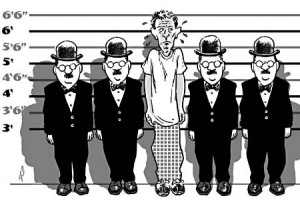If you’ve ever seen a crime/police movie, you’re probably familiar with the basic procedure involved in a police lineup. The victim of a crime gives a description of their assailant. Based on this, and other evidence, the police track down a prime suspect. They have the prime suspect stand against a wall, along with several other people with a similar physical description.
The witness hems and haws for a few minutes, before finally pointing out the prime suspect, and the cops have their man.

There have been several documented cases of innocent people going to prison based on a witness at a police lineup misidentifying them.
Over the past decades, the process of police lineups has improved significantly. The method was (and sometimes still is) often used haphazardly, with few or no controls to correct for the basic nature of human psychology. Typically, the police would assemble a lineup already having a prime suspect in mind. They would then make it very clear to the witness who this suspect is.
Being in a stressful situation, the witness would probably be highly vulnerable to suggestion. This is on top of the fact that most people are naturally pretty susceptible to suggestion, anyway. Detectives, over time, got very good a “subtly” suggesting to the witness who they liked as a suspect, which usually led to the witness identifying the person the police want them to identify, whether or not they actually remember enough to make such an identification.
In recent decades, however, the process has improved significantly. The Supreme Court has ruled that suspects called to appear in a police lineup have a right to have their attorney present. The attorney can help ensure that the proper procedures (designed to avoid undue suggestion) are followed.
Some large police departments have taken elaborate measures to eliminate suggestion in police lineups. For example, some police departments have employees whose primary job is to oversee police lineups. They are the only people who interact with the witness. They are not told who in the lineup, if anyone, the primary suspect is. In theory this should prevent them from doing anything to influence the witness’s identification. After all, if an officer who’s directly involved in the investigation knows who the primary suspect is, they might subconsciously influence the witness, even if they’re making a conscious effort to avoid doing so.
Another method involves dispensing with “lineups” altogether, and showing the witness a collection of photographs. After all, if a group of suspects are physically present, the officer giving them instructions might speak to the prime suspect in a different manner from the other suspects. Using photographs is a good way to avoid this.
However, according to the Times article, many police departments have not made the necessary reforms, and still rely on outdated lineup procedures.
Part of this is probably due to a lack of funds, and the fact that many smaller police departments probably don’t have to conduct lineups very often, so the benefits of reforming lineup procedures don’t seem to be worth the cost of implementing the necessary reforms.
However, the article points out that most police departments, once they reformed lineup procedure, found that their detectives reacted positively to the changes, despite initial resistance. After all, a process that leads to more accurate witness identifications should make any detective happy.
Hopefully, all police departments will institute commonsense reforms to their police lineup procedure. Besides protecting innocent people being wrongfully convicted (which is, of course, the primary reason why these reforms are needed), they should also benefit police departments and prosecutors, who will have more confidence that they’ve charged the right person based on a witness identification. This should lead to fewer convictions being overturned on appeal, which everyone involved in law enforcement should like.
